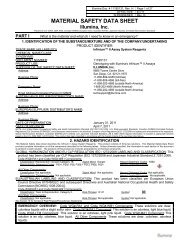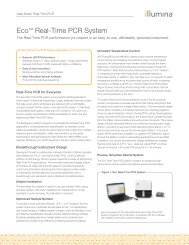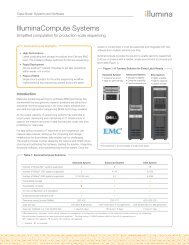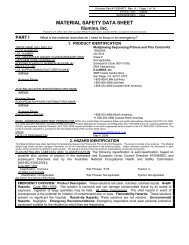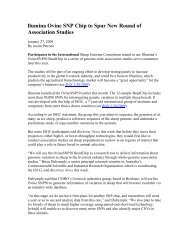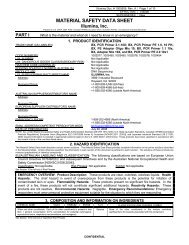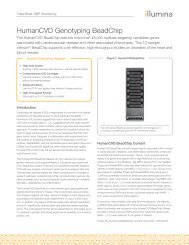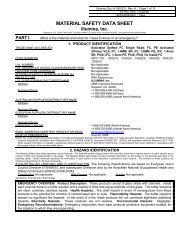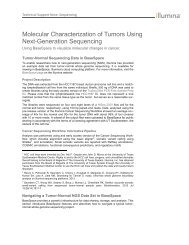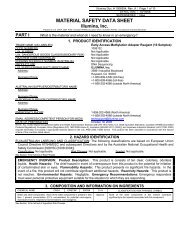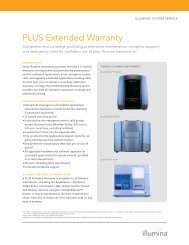MATERIAL SAFETY DATA SHEET - Illumina
MATERIAL SAFETY DATA SHEET - Illumina
MATERIAL SAFETY DATA SHEET - Illumina
You also want an ePaper? Increase the reach of your titles
YUMPU automatically turns print PDFs into web optimized ePapers that Google loves.
TruSeq Enrichment Kit <strong>Illumina</strong> Doc. #15018476, Rev. A Page 7 of 17<br />
10. STABILITY AND REACTIVITY (Continued)<br />
<strong>MATERIAL</strong>S WITH WHICH SUBSTANCE IS INCOMPATIBLE:<br />
GA#-HP3: Aluminum and other metals, acid solutions, acidic chemicals, amines, ammonia, urea, ammonium compounds,<br />
cellulose, methanol, aziridine, phenyl acetonitrile, ethylene imine, and bisulfates.<br />
TC#-CT1, TC#-SMB, and TC#-WS1: Karl Fischer reagent (mixture of toluene, pyridine and sulfur trioxide), strong oxidizers,<br />
strong acids, some metals, substances that are incompatible with water.<br />
All Other Solutions: Strong oxidizers, strong acids, some metals and substances which are incompatible with water.<br />
HAZARDOUS POLYMERIZATION: Will not occur.<br />
CONDITIONS TO AVOID: Mixing with incompatible chemicals or as given above.<br />
PART IV Is there any other useful information about this material?<br />
11. TOXICOLOGICAL INFORMATION<br />
GA#-HP3<br />
HAZARDOUS <strong>MATERIAL</strong> IDENTIFICATION SYSTEM<br />
TC#-CT1, TC#-SMB, AND TC#-WS1<br />
HAZARDOUS <strong>MATERIAL</strong> IDENTIFICATION SYSTEM<br />
HEALTH HAZARD<br />
(BLUE)<br />
3<br />
HEALTH HAZARD<br />
(BLUE)<br />
2<br />
FLAMMABILITY HAZARD<br />
(RED)<br />
0<br />
FLAMMABILITY HAZARD<br />
(RED)<br />
0<br />
PHYSICAL HAZARD<br />
(YELLOW)<br />
0<br />
PHYSICAL HAZARD<br />
(YELLOW)<br />
0<br />
PROTECTIVE EQUIPMENT<br />
PROTECTIVE EQUIPMENT<br />
EYES RESPIRAT ORY HANDS BODY<br />
EYES RESPIRAT ORY HANDS BODY<br />
SEE SECTION 8<br />
SEE SECTION 8<br />
SEE SECTION 8<br />
SEE SECTION 8<br />
For Routine Use and Handling Applications<br />
For Routine Use and Handling Applications<br />
Hazard Scale: 0 = Minimal 1 = Slight 2 = Moderate<br />
3 = Serious 4 = Severe * = Chronic hazard<br />
SYMPTOMS OF OVEREXPOSURE BY ROUTE OF EXPOSURE: No adverse health effects should occur from<br />
routine, occupational use of this product’s solutions in the manner specified by the manufacturer's instructions. The<br />
potential health effects of this product’s solutions, via route of exposure, are described below.<br />
INHALATION:<br />
GA#-HP3: Inhalation of mists or sprays of this component can cause difficulty breathing, irritation of the mucus membranes,<br />
coughing, nasal congestion, and a sore throat. Prolonged inhalation exposures or exposures to high concentrations of this<br />
component can damage the tissues of the respiratory system. The effects of inhalation exposure may be delayed up to 48<br />
hours. Severe inhalation overexposures can cause chemical pneumonitis, pulmonary edema, and death. Repeated, low level<br />
exposure can damage the respiratory system, including emphysema.<br />
TC#-CT1, TC#-SMB, and TC#-WS1: Inhalation of vapors, mists, or sprays of these components will irritate the nose, throat, and<br />
lungs. Symptoms may include nausea, headache, and vomiting.<br />
All Other Solutions: Inhalation of vapors, mists, or sprays of these solutions may slightly irritate the nose, throat, and lungs.<br />
Symptoms are generally alleviated upon breathing fresh air.<br />
CONTACT WITH SKIN or EYES:<br />
GA#-HP3: This component is extremely corrosive and capable of causing severe burns with deep ulceration and permanent<br />
scarring. This component can penetrate to deeper layers of skin and corrosion will continue until removed. The severity of<br />
injury depends on the duration of exposure. Burns may not be immediately painful; onset of pain may be delayed minutes to<br />
hours. Eye contact will cause severe irritation or burns. The severity of injury increases with the duration of exposure and the<br />
speed of penetration into the eye. Damage can range from mild scarring to blistering, disintegration, ulceration, severe scarring,<br />
and clouding. Glaucoma and cataracts are possible late developments. In severe cases, there is progressive ulceration and<br />
clouding of eye tissue, which may cause permanent blindness.<br />
TC#-CT1, TC#-SMB, and TC#-WS1: Depending on the duration and concentration of overexposure, skin and eye contact can<br />
irritate contaminated tissue. Symptoms of skin overexposure may include redness and discomfort. Symptoms of eye<br />
overexposure may include redness, tearing, and pain.<br />
All Other Solutions: Contact with the skin or eyes may cause mild irritation, which is alleviated upon rinsing.



